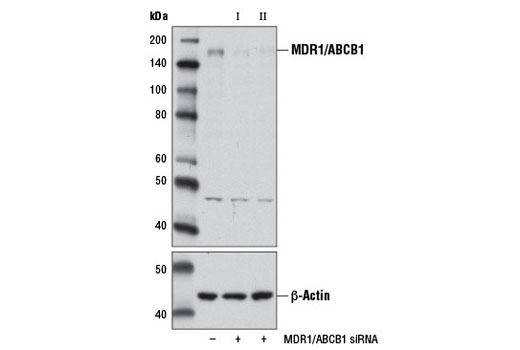#P08183
5243
Product Information
Product Usage Information
CST recommends transfection with 100 nM SignalSilence® MDR1/ABCB1 siRNA II 48 to 72 hours prior to cell lysis. For transfection procedure, follow protocol provided by the transfection reagent manufacturer. Please feel free to contact CST with any questions on use.
Each vial contains the equivalent of 100 transfections, which corresponds to a final siRNA concentration of 100 nM per transfection in a 24-well plate with a total volume of 300 μl per well.
Storage
Specificity / Sensitivity
Species Reactivity:
Human
Species predicted to react based on 100% sequence homology
The antigen sequence used to produce this antibody shares
100% sequence homology with the species listed here, but
reactivity has not been tested or confirmed to work by CST.
Use of this product with these species is not covered under
our
Product Performance Guarantee.
Monkey
Product Description
Background
MDR1/ABCB1 belongs to the Mdr/Tap subfamily of the ATP-binding cassette transporter superfamily (1). Multidrug resistance 1 (MDR1) serves as an efflux pump for xenobiotic compounds with broad substrate specificity. MDR1 substrates include therapeutic agents such as actinomycin D, etoposide, imatinib, and doxorubicin, as well as endogenous molecules including β-amyloids, steroid hormones, lipids, phospholipids, cholesterol, and cytokines (2). Research studies have shown that MDR1 reduces drug accumulation in cancer cells, allowing the development of drug resistance (3-5). On the other hand, MDR1 expressed in the plasma membrane of cells in the blood-brain, blood-cerebral spinal fluid, or blood-placenta barriers restricts the permeability of drugs into these organs from the apical or serosal side (6,7). MDR1 is also expressed in normal tissues with excretory function such as small intestine, liver, and kidney (7). Intracellular MDR1 has been detected in the ER, vesicles, and nuclear envelope, and has been associated with cell trafficking machinery (8). Other reported functions of MDR1 include viral resistance, cytokine trafficking (9,10), and lipid homeostasis in the peripheral and central nervous system (11-13).
- Furuya, K.N. et al. (1997) Cancer Res 57, 3708-16.
- Litman, T. et al. (1997) Biochim Biophys Acta 1361, 169-76.
- Chen, C.J. et al. (1986) Cell 47, 381-9.
- Kartner, N. et al. (1983) Cancer Res 43, 4413-9.
- Chen, G. et al. (1997) J Biol Chem 272, 5974-82.
- Brinkmann, U. and Eichelbaum, M. (2001) Pharmacogenomics J 1, 59-64.
- Fromm, M.F. (2004) Trends Pharmacol Sci 25, 423-9.
- Miller, D.S. et al. (2008) Pharmacol Rev 60, 196-209.
- Ambudkar, S.V. et al. (1999) Annu Rev Pharmacol Toxicol 39, 361-98.
- Raviv, Y. et al. (2000) FASEB J 14, 511-5.
- Meijer, O.C. et al. (2003) J Endocrinol 178, 13-8.
- Karssen, A.M. et al. (2002) J Endocrinol 175, 251-60.
- Jeannesson, E. et al. (2009) Clin Chim Acta 403, 198-202.
Species Reactivity
Species reactivity is determined by testing in at least one approved application (e.g., western blot).
Cross-Reactivity Key
H: human M: mouse R: rat Hm: hamster Mk: monkey Vir: virus Mi: mink C: chicken Dm: D. melanogaster X: Xenopus Z: zebrafish B: bovine Dg: dog Pg: pig Sc: S. cerevisiae Ce: C. elegans Hr: horse GP: Guinea Pig Rab: rabbit All: all species expected
Trademarks and Patents
Limited Uses
Except as otherwise expressly agreed in a writing signed by a legally authorized representative of CST, the following terms apply to Products provided by CST, its affiliates or its distributors. Any Customer's terms and conditions that are in addition to, or different from, those contained herein, unless separately accepted in writing by a legally authorized representative of CST, are rejected and are of no force or effect.
Products are labeled with For Research Use Only or a similar labeling statement and have not been approved, cleared, or licensed by the FDA or other regulatory foreign or domestic entity, for any purpose. Customer shall not use any Product for any diagnostic or therapeutic purpose, or otherwise in any manner that conflicts with its labeling statement. Products sold or licensed by CST are provided for Customer as the end-user and solely for research and development uses. Any use of Product for diagnostic, prophylactic or therapeutic purposes, or any purchase of Product for resale (alone or as a component) or other commercial purpose, requires a separate license from CST. Customer shall (a) not sell, license, loan, donate or otherwise transfer or make available any Product to any third party, whether alone or in combination with other materials, or use the Products to manufacture any commercial products, (b) not copy, modify, reverse engineer, decompile, disassemble or otherwise attempt to discover the underlying structure or technology of the Products, or use the Products for the purpose of developing any products or services that would compete with CST products or services, (c) not alter or remove from the Products any trademarks, trade names, logos, patent or copyright notices or markings, (d) use the Products solely in accordance with CST Product Terms of Sale and any applicable documentation, and (e) comply with any license, terms of service or similar agreement with respect to any third party products or services used by Customer in connection with the Products.
